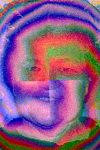The edges of the tetrahedrons are the diagonals across the square faces of a web-safe-216-color cube.
Each of the eight triangles centers on a corner of the cube. Red, green, blue (RGB) corners connect to the black corner, centering triangle White 1. Cyan, magenta, and yellow corners connect to the white corner (CMYK), centering triangle Black 3 (filled with black dots). The filling shapes are the color of their tetrahedron (black or white) tinted by the respective cube corner color.
I learned about the color cube in 1997 working with web colors for 8-bit displays. I put my modest research on a Color Access page (see RESOURCES link below). Some names for it are browser-safe web palette, Netscape palette, 216-color palette, or 6x6x6 color cube. Note that the colors are separated by neutral lines, but in a cube with millions of colors there would be no shapes, the colors would blend into each other with no visible separation. I'm not sure how a cube layout would look or work as a spherical panorama but I guess it would just be finer gradations.
Actually, the cube is not hollow. Note a different arrangement of colors in my previous QTVR of web colors (link below). Also see the link "Color cube views: outer and inner layers". My Wholeo Online page has Alice (of Wonderland) in a Duo-Tet Cube shown from the outside. That page is study 6 of my entry to the 2009 Buckminster Fuller Challenge and Google's Project 10^100, which hopefully will show why this is important.
Previous QTVR of web colors
Color cube views: outer and inner layers
Rotating cube and good discussion
Evolution of the Duo-Tet Cube by R. Buckminster Fuller
Artistica / Virtual worlds
GPS location unavailable (not recorded, no physical location depicted or intentionally suppressed)
Precision is: Suppressed. Will not show on map.
The color cube has only half the hues blending to black: red, green and blue: RGB. The other half of the hues blend to white: cyan, yellow, and magenta (CYMK). How does this compare to a color wheel sphere? Stop, that's wrong, RGB colors blend to white diagonally. But all value blends are also hue blends. I am far from understanding different color systems. Today I enjoy this one.
Alternative titling: I am a color being in a cubical world. I am color in cube. Color being in cube.
Alternative text: i am wwp cube color sphere equinox global being mala web is 0




 Tap or click the zoom icon in the bottom right corner of the picture to switch between in-page and fullscreen view
Tap or click the zoom icon in the bottom right corner of the picture to switch between in-page and fullscreen view